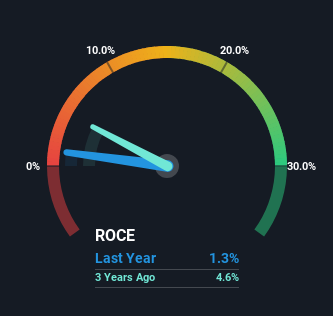There Are Reasons To Feel Uneasy About Spark Power Group's (TSE:SPG) Returns On Capital
There are a few key trends to look for if we want to identify the next multi-bagger. Firstly, we'll want to see a proven return on capital employed (ROCE) that is increasing, and secondly, an expanding base of capital employed. Put simply, these types of businesses are compounding machines, meaning they are continually reinvesting their earnings at ever-higher rates of return. However, after investigating Spark Power Group (TSE:SPG), we don't think it's current trends fit the mold of a multi-bagger.
Return On Capital Employed (ROCE): What Is It?
For those that aren't sure what ROCE is, it measures the amount of pre-tax profits a company can generate from the capital employed in its business. To calculate this metric for Spark Power Group, this is the formula:
Return on Capital Employed = Earnings Before Interest and Tax (EBIT) ÷ (Total Assets - Current Liabilities)
0.013 = CA$1.5m ÷ (CA$213m - CA$94m) (Based on the trailing twelve months to June 2023).
Therefore, Spark Power Group has an ROCE of 1.3%. In absolute terms, that's a low return and it also under-performs the Renewable Energy industry average of 3.4%.
View our latest analysis for Spark Power Group
Historical performance is a great place to start when researching a stock so above you can see the gauge for Spark Power Group's ROCE against it's prior returns. If you're interested in investigating Spark Power Group's past further, check out this free graph of past earnings, revenue and cash flow.
The Trend Of ROCE
When we looked at the ROCE trend at Spark Power Group, we didn't gain much confidence. Over the last four years, returns on capital have decreased to 1.3% from 13% four years ago. On the other hand, the company has been employing more capital without a corresponding improvement in sales in the last year, which could suggest these investments are longer term plays. It's worth keeping an eye on the company's earnings from here on to see if these investments do end up contributing to the bottom line.
On a side note, Spark Power Group's current liabilities are still rather high at 44% of total assets. This can bring about some risks because the company is basically operating with a rather large reliance on its suppliers or other sorts of short-term creditors. Ideally we'd like to see this reduce as that would mean fewer obligations bearing risks.
What We Can Learn From Spark Power Group's ROCE
Bringing it all together, while we're somewhat encouraged by Spark Power Group's reinvestment in its own business, we're aware that returns are shrinking. And investors may be expecting the fundamentals to get a lot worse because the stock has crashed 83% over the last five years. Therefore based on the analysis done in this article, we don't think Spark Power Group has the makings of a multi-bagger.
If you'd like to know about the risks facing Spark Power Group, we've discovered 1 warning sign that you should be aware of.
While Spark Power Group isn't earning the highest return, check out this free list of companies that are earning high returns on equity with solid balance sheets.
Have feedback on this article? Concerned about the content? Get in touch with us directly. Alternatively, email editorial-team (at) simplywallst.com.
This article by Simply Wall St is general in nature. We provide commentary based on historical data and analyst forecasts only using an unbiased methodology and our articles are not intended to be financial advice. It does not constitute a recommendation to buy or sell any stock, and does not take account of your objectives, or your financial situation. We aim to bring you long-term focused analysis driven by fundamental data. Note that our analysis may not factor in the latest price-sensitive company announcements or qualitative material. Simply Wall St has no position in any stocks mentioned.

